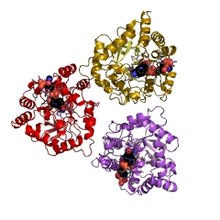Chlordecone reductase
Appearance
| chlordecone reductase | |||||||||
|---|---|---|---|---|---|---|---|---|---|
 | |||||||||
| Identifiers | |||||||||
| EC no. | 1.1.1.225 | ||||||||
| CAS no. | 102484-73-1 | ||||||||
| Databases | |||||||||
| IntEnz | IntEnz view | ||||||||
| BRENDA | BRENDA entry | ||||||||
| ExPASy | NiceZyme view | ||||||||
| KEGG | KEGG entry | ||||||||
| MetaCyc | metabolic pathway | ||||||||
| PRIAM | profile | ||||||||
| PDB structures | RCSB PDB PDBe PDBsum | ||||||||
| Gene Ontology | AmiGO / QuickGO | ||||||||
| |||||||||
In enzymology, a chlordecone reductase (EC 1.1.1.225) is an enzyme that catalyzes the chemical reaction
- chlordecone alcohol + NADP+ chlordecone + NADPH + H+
Thus, the two substrates of this enzyme are chlordecone alcohol and NADP+, whereas its 3 products are chlordecone, NADPH, and H+.
This enzyme belongs to the family of oxidoreductases, specifically those acting on the CH-OH group of donor with NAD+ or NADP+ as acceptor. The systematic name of this enzyme class is chlordecone-alcohol:NADP+ 2-oxidoreductase. This enzyme is also called CDR.
Structural studies
As of late 2007, only one structure has been solved for this class of enzymes, with the PDB accession code 2FVL.
References
- Molowa DT, Shayne AG, Guzelian PS (1986). "Purification and characterization of chlordecone reductase from human liver". J. Biol. Chem. 261 (27): 12624–7. PMID 2427522.

